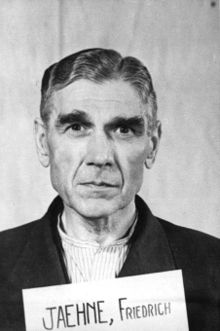Friedrich Jähne

Friedrich Jähne (born October 24, 1879 in Neuss , † December 21, 1965 in Munich ) was a German engineer, entrepreneur and military economist .
life and work
Jähne, son of a photographer, finished his school career in Neuss and Düsseldorf with the Abitur . He then worked in Kiel at the imperial shipyard and was involved in the suppression of the Boxer Rebellion as a marine in 1900 . From 1901 to 1905 he studied mechanical engineering at the Technical University of Charlottenburg . During his studies in 1901 he became a member of the Berlin fraternity Rugia . After graduating, he worked as a production engineer for various companies in the chemical industry. Jähne took part in the First World War as a marine .
He joined the Bayer paint factory in Leverkusen in 1921 , became an authorized signatory in 1923 and a director in 1928 - after Bayer joined IG Farbenindustrie AG . On October 6, 1931, Jähne became chief engineer at the Hoechst plant and in the Mittelrhein operating group of IG Farben and chairman of the technical commission . Under his leadership, the fundamental modernization of the infrastructure of the plant, which was founded in 1863, began, which lasted until 1939. This included the generous construction of new streets and expansion areas, the reorganization of the works railway network and the establishment of a central electricity and steam supply in place of the earlier small power plants and transmission drives. Between 1932 and 1939, about 10 million were annually Reichsmark invested.
In 1934 Jähne was appointed deputy member of the IG Farben board. After the death of the plant manager Ludwig Hermann on May 31, 1938, he was promoted to full board member of IG Farben and deputy plant manager of Hoechst . Shortly beforehand, he and the new plant manager Carl Lautenschläger applied for membership in the NSDAP , which accepted him retrospectively from May 1, 1937. Jähne received during the Second World War , the War Merit Cross First Class and became the 1943 Wehrwirtschaftsführer appointed.
Jähne was considered unreliable in the party hierarchy, but apparently had no concerns about the involvement of IG Farben in the National Socialist war economy. B. because of the scheduled deployment of forced labor in the Auschwitz-Monowitz concentration camp . During the war, Jähne stayed several times in the Buna works in the concentration camp, and his son also worked there as an engineer. From him he also found out about the mass murders in the Auschwitz-Birkenau concentration camp, six kilometers from IG Farbenwerk .
In the IG Farben trial , Jähne was sentenced to 18 months in prison on July 30, 1948. He was released from Landsberg Detention Center on October 17 of the same year.
In September 1955 he became chairman of the supervisory board of Farbwerke Hoechst (until 1963). In 1955 he also received the DECHEMA Medal , and in 1960 he was awarded the Grand Order of Merit with a Star . He was also a bearer of the Bavarian Order of Merit (awarded on June 23, 1962). In 1962 he was awarded the Grashof Memorial Medal by the Association of German Engineers .
literature
- Stephan Lindner : Hoechst. An IG Farben plant in the Third Reich . Verlag CH Beck, Munich 2005, ISBN 3-406-52959-3 .
- Ernst Klee : The dictionary of persons on the Third Reich. Who was what before and after 1945 . 2nd updated edition. Fischer, Frankfurt am Main 2007, ISBN 978-3-596-16048-8 .
- Jens Ulrich Heine: Mind & Fate. The men of IG Farbenindustrie AG (1925–1945) in 161 short biographies . Chemie, Weinheim 1990, ISBN 3-527-28144-4 .
- Hypocrisy and favoritism . In: Junge Welt . July 28, 1948.
Web links
- Biography Friedrich Jähne. In: Wollheim Memorial. Retrieved August 7, 2009 .
- 7. IG Farben and its successors to this day. Retrieved August 7, 2009 .
- The IG Farben managers. Retrieved August 7, 2009 .
Individual evidence
- ↑ Willy Nolte (Ed.): Burschenschafter Stammrolle. List of the members of the German Burschenschaft according to the status of the summer semester 1934. Berlin 1934. S. 222.
- ↑ a b biography of Friedrich Jähne. In: Wollheim Memorial. Retrieved August 7, 2009 .
- ↑ a b Ernst Klee : The dictionary of persons on the Third Reich. Who was what before and after 1945 . 2nd updated edition. Fischer, Frankfurt am Main 2007, ISBN 978-3-596-16048-8 , pp. 281 .
| personal data | |
|---|---|
| SURNAME | Jaehne, Friedrich |
| BRIEF DESCRIPTION | German entrepreneur |
| DATE OF BIRTH | October 24, 1879 |
| PLACE OF BIRTH | Neuss |
| DATE OF DEATH | December 21, 1965 |
| Place of death | Munich |